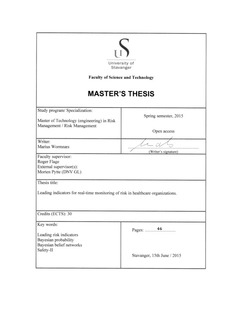| dc.contributor.author | Wormnæs, Marius | |
| dc.date.accessioned | 2015-09-25T12:21:10Z | |
| dc.date.available | 2015-09-25T12:21:10Z | |
| dc.date.issued | 2015-06 | |
| dc.identifier.uri | http://hdl.handle.net/11250/302066 | |
| dc.description | Master's thesis in Risk management | nb_NO |
| dc.description.abstract | Thousands of Norwegian patients experience serious injury and death every year due to preventable adverse events. Risk management in healthcare is a relatively new discipline. Methods from other high-risk sectors, for instance aerospace, have been adopted without sufficient success. Healthcare consists of highly complex sociotechnical systems and thus differs from other high-risk sectors.
Existing risk and safety management methods should be supplied with new approaches to prevent patient harm. This thesis is an attempt to contribute to the development of a leading risk indicator framework by proposing some fundamental characteristics.
Leading indicators can monitor real-time changes in risk related to patient harm. Adjustments to the activities based on information about changes in the risk picture can prevent adverse events and maximize patient safety.
This view of safety is in accordance with the concept of Safety-II. The principle is to anticipate rather than experience hazards, and adapt to situations rather than respond to unwanted events.
Leading risk indicators that change before the risk level changes provide the opportunity to make adjustments before adverse events occur. That is a condition for indicators to be categorized as leading.
The System-Theoretic Accident Model and Processes (STAMP) identifies leading indicators by assessing the vulnerability of safety-critical assumptions . In order to reduce heuristic biases, the vulnerability assessment is related to the plausibility and severity potential of a hazard.
Safety-critical assumptions include barriers, as well as other risk and safety influencing factors. The majority of barriers in healthcare are procedural, and human factors are important barrier influencing factors.
The presence of human factors is influenced by the safety culture of an organization. The safety culture includes the attitude, awareness and approach to safety of personnel at all levels.
Approaches and methods from other high-risk sectors have been reviewed. The thesis concludes that elements from approaches and methods may be combined as a basis for further development of an appropriate leading risk indicator framework.
The thesis also concludes that the use of Bayes Nets provides a powerful modeling tool of leading risk indicator systems. Certain elements of a leading risk indicator model are suggested. | nb_NO |
| dc.publisher | University of Stavanger, Norway | nb_NO |
| dc.rights | CC0 1.0 Universal | * |
| dc.rights.uri | http://creativecommons.org/publicdomain/zero/1.0/ | * |
| dc.subject | Bayesian probability | nb_NO |
| dc.subject | Bayesian belief networks | nb_NO |
| dc.subject | Safety-II | nb_NO |
| dc.subject | risikostyring | nb_NO |
| dc.subject | leading risk indicators | nb_NO |
| dc.title | Leading indicators for real-time monitoring of risk in healthcare organizations. | nb_NO |
| dc.type | Master thesis | nb_NO |
| dc.subject.nsi | VDP::Social science: 200 | nb_NO |

